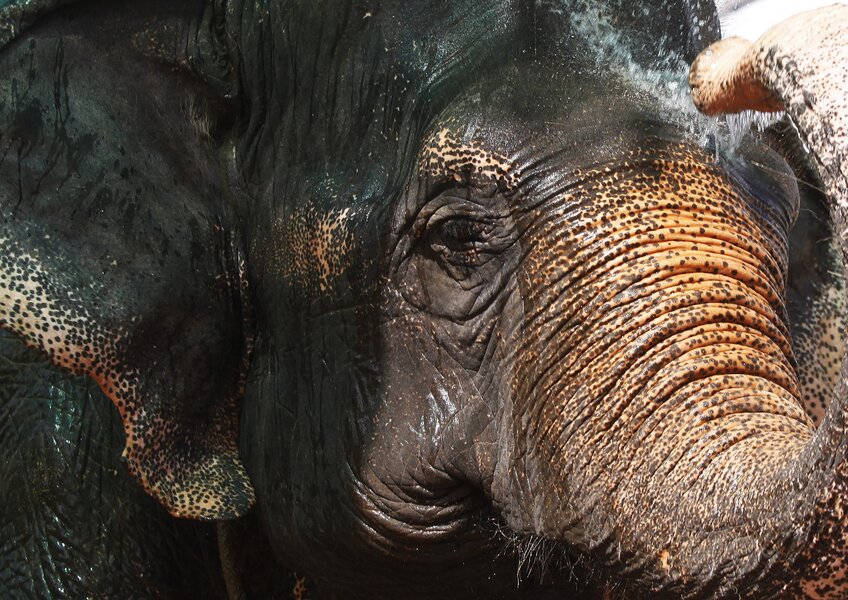How one dead elephant could change Cambodia's tourism industry
Loading...
A female elephant named Sambo collapsed and died Friday near Cambodia's Angkor Wat, the Phnom Penh Post reports. Trained to carry tourists around the ancient temple for the past 15 years, Sambo died from overworking in temperatures reaching above 100 degrees F.
Angkor Elephant Company owner Oam Kiri tells the Associated Press that Sambo's death led him to reduce the workday of his remaining elephants by one hour: two and a half hours in the morning, and another two in late afternoon.
For many conservationists and concerned travelers, however, that concession isn't enough.
And as of Tuesday afternoon, a Change.org petition to end elephant riding at the Angkor archaeological park in Siem Reap, Cambodia had more than 38,000 signatures. Organizers are hoping for 50,000.
"There is no such thing as cruelty-free elephant rides," reads the petition, which is directed at Cambodian authorities responsible for managing the Angkor archaeological park, including its conservation and tourism industry. "What you don't realise," the petition tells tourists, "is that a 'once in a lifetime' or 'bucket list' item for you, means a lifetime of misery for wild animals."
The Angkor Elephant Company, operating outside of Cambodia's most famous tourist attraction, Angkor Wat, has 13 elephants after Sambo's death – the largest concentration of captive elephants in the country. Over 2 million tourists visited Angkor Wat in 2015, many of them enjoying nearby elephant rides.
However, working elephants' unnatural lifestyles and abusive training is typically hidden from visitors, says Elizabeth Hogan, the US Wildlife Campaign manager for World Animal Protection, an organization focused on ending animal cruelty for profit.
"The very sad death of Sambo is yet another example of why elephants belong in the wild, not in captivity to give rides to tourists," Ms. Hogan tells The Christian Science Monitor in a phone interview. "Tourists may think that riding an elephant does no harm, but the suffering behind the scenes of cruel wildlife venues is often hidden from view."
The International Union for the Conservation of Nature (IUCN) has listed Asian elephants as endangered since 1986, witnessing a 50 percent population decline between the past 60 to 75 years from poaching and habitat loss. Populations currently live in 12 other South Asia and South-east Asia countries besides Cambodia, but all local populations continue to decline.
It is difficult to estimate the total population numbers of Asian elephants because of their affinity for dense vegetation and rough terrain, but the IUCN Red List estimates the global population size to be somewhere between 40,000 to 52,300. Cambodia has one of the smallest Asian elephant populations, likely constituting less than 1 percent of the overall species.
Asian elephants are primarily found in the country's southwest mountains in the Mondulkiri province, an important part of the indigenous Bunong people's culture and history. Whereas the Bunong people used to regularly capture elephants for domestication, the practice has declined within the past 20 years because of the species' increasing rarity, as well as substantive efforts by the Cambodian government, specifically the Forestry Administration, to reduce the number of animals in captivity.
"The Asian elephant is protected under Cambodian law, with illegal killings and attempts to trade in elephant parts punishable by a lengthy jail sentence," Matthew Maltby, from Fauna and Flora International, and Gavin Bourchier, from the Perth Zoo in Australia, explain in their 2011 study of Asian elephants in Cambodia. "However, the resources and capacity of law enforcement officials to combat wildlife crime ... is limited and combined with a weak penal system, successful prosecutions of offenders are seldom seen."
Although all owners of captive elephants in Cambodia are required to register their animals with the country's Forestry Administration, estimates of current captive elephant populations vary widely. Maltby and Bourchier suggest the current captive Asian elephant population in Cambodia will die out within the next 10 to 20 years because of inadequate care for older individuals.
Tourists pay roughly $30 for elephant rides, according to the Phnom Penh Post, and resting elephants more frequently could create financial hardships for families working in the growing ecotourist sector. But some captivity opponents say adequate rest and comfortable living conditions for the animals have their own financial incentive as it may prolong the elephants' life expectancy.
"Conditions should be regulated, if working Cambodia's last remaining elephants is what Cambodia actually wants to do," Jack Highwood, founder of the Elephant Valley Project, told The Phnom Penh Post.








